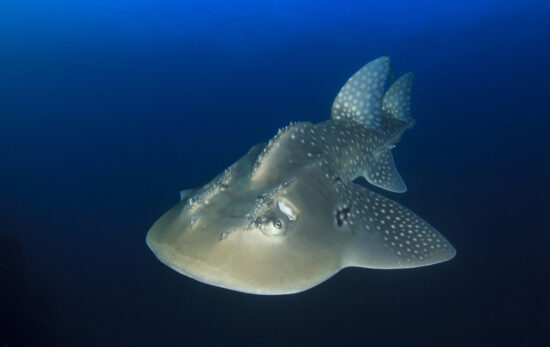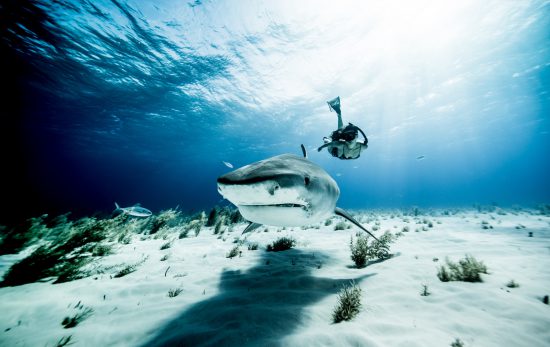Have you seen a snake in the ocean? Ever wondered how such snakes differed from the ones found on land? These amazing animals have been entertaining scuba divers throughout the Indo-Pacific Ocean for years, long before sea snakes became the subject of one of our most popular viral Facebook posts. Let’s learn a little about these often-feared but truly fascinating creatures with some sea snake facts.
Here are 16 sea snake facts to answer all your questions about these curious reptiles.
1. There are 69 species of sea snakes.
While divers usually only see a handful of sea snake species during their time underwater, there are actually 69 identified species. To keep things simple, scientists separate these species into two categories: true sea snakes and sea kraits. True sea snakes spend almost all their time at sea, while sea kraits split their time between land and sea.
2. It’s all about the tail.
While it’s impractical to analyze the DNA of every snake-like creature you come across, an easy way to identify sea snakes (from their land-based cousins) is by their paddle-like tails. The flat tails help sea snakes propel themselves gracefully through the water, but these appendages do make them slightly clumsier on land.
Pro Tip: Many people confuse sea snakes with eels. The most reliable way to differentiate between the two is to look for the presence of a dorsal fin. Eels have a ridge or fin that runs the length of their bodies, while sea snakes do not.
3. There are no sea snakes in the Atlantic Ocean.
Sea snakes live in the tropical and subtropical waters of the Indian and Pacific Oceans. They are not found in the Atlantic Ocean or the Caribbean Sea. Sea snakes are also not found in areas of high salinity, such as the Red Sea.
4. Sea snakes have been around for millions of years.
The first sea snakes began to evolve about six to eight million years ago in Southeast Asia’s Coral Triangle. However, most species only evolved one to three million years ago.
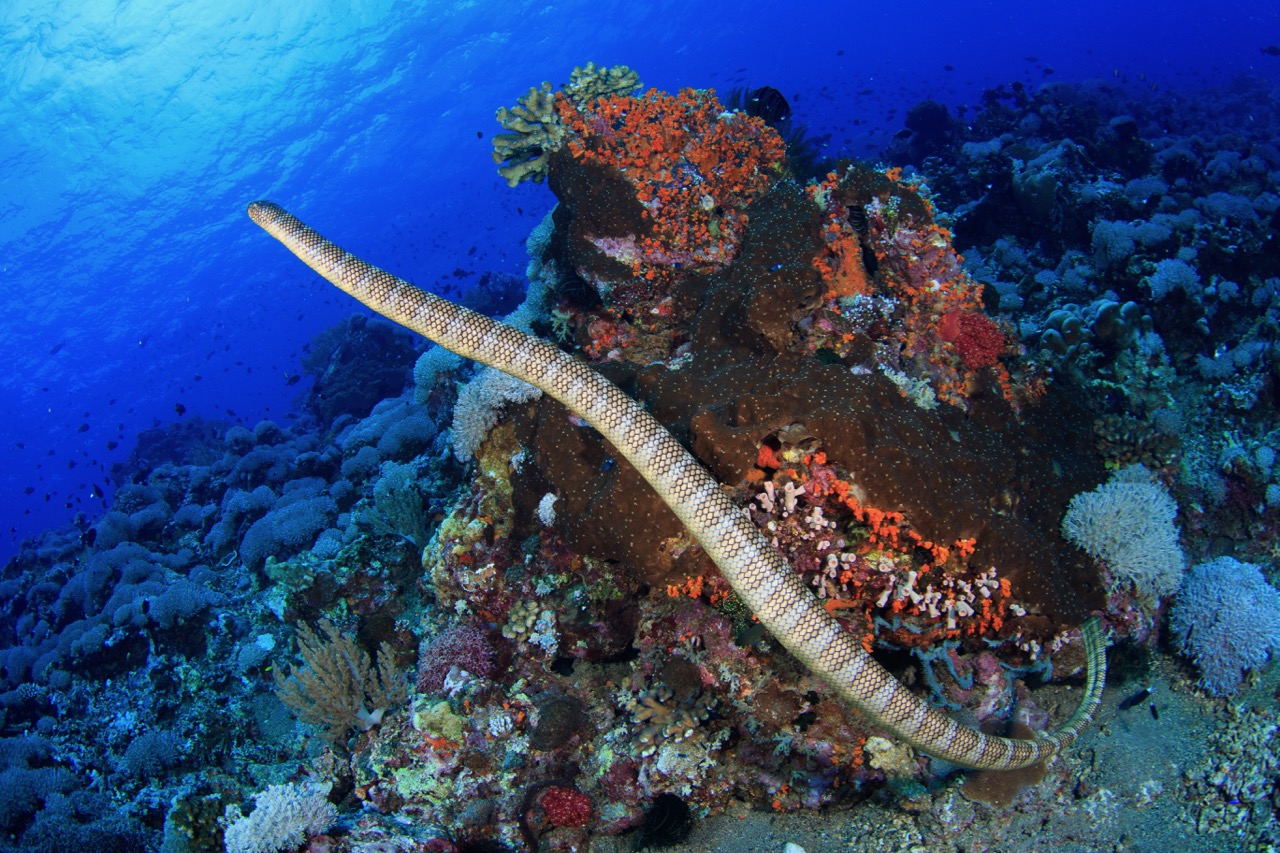
5. They are the only reptiles to give birth in the ocean.
Most true sea snakes are ovoviviparous, meaning females give live birth from eggs stored in the snake’s body. This is because these snakes rarely visit land, and their eggs won’t incubate underwater. Therefore, the females keep the eggs and give birth to nearly fully formed snakes while swimming in the ocean. However, while this is true for the majority of sea snakes, not all sea snakes actually give birth in the ocean to live young. One genus of sea snake, which includes the commonly observed yellow-lipped sea krait, is actually oviparous and comes onto land to lay eggs.
6. Sea snakes can hold their breath for a really long time.
Unlike fish, sea snakes need to breathe air. Every species must return to the surface periodically to survive. While most sea snakes surface every 30 minutes or so to breathe, some true sea snakes can stay underwater for up to eight hours. That’s because these snakes actually absorb up to 33% of the oxygen they need through their skin. They can also get rid of 90% of their carbon dioxide in the same manner.
7. Sea snakes can die of thirst.
The well-known, turmoil-ridden phrase, ”Water, water, everywhere and not a drop to drink,” doesn’t just apply to humans. It also applies to sea snakes, as these reptilian seafarers still need to drink fresh water to survive. Of course, spending all day at sea is not conducive to consuming fresh water. Some snake species head to land to find water, while others wait for rain to deposit fresh water on the surface of the ocean which they can then drink while swimming.
8. They have special glands to remove salt water.
Although sea snakes don’t drink salt water, they still consume a lot of salt when hunting and consuming prey. To prevent excess salt intake, the snakes have evolved special sublingual glands. These glands sit under the snakes’ tongues and push out salt from the bloodstream into the mouth, meaning the snake can simply flick its tongue and expel the unwelcome salt.
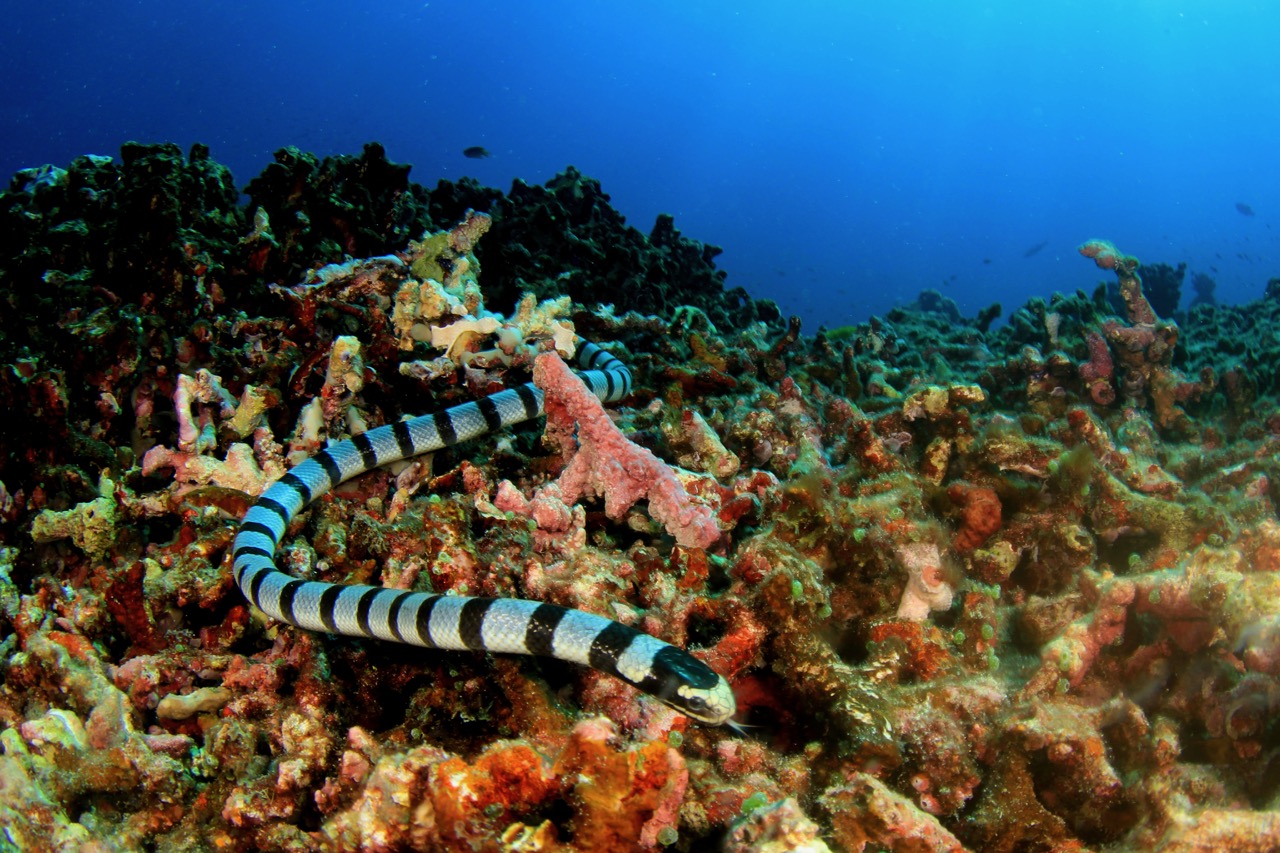
9. They can dive deeper than scuba divers.
In fact, sea snakes can dive to depths of up to 800 feet (250 meters) in search of prey. Most sea snakes, however, prefer to stay in the shallows, relatively close to shore.
10. Sea snakes need not worry about breathing in water.
Most sea snakes have evolved valve-like flaps they can move over their nostrils when underwater. This prevents them from breathing in any salty water. (If only scuba divers could evolve in the same way!)
11. Sea snakes are carnivores.
The diets of sea snakes vary across species, but most such snakes prefer to prey on fish, especially eels. Some also enjoy dining on mollusks, such as prawns, as well as crustaceans. Many reef-dwelling sea snakes have developed small heads and long, thin necks that allow them to poke their heads into nooks and crannies in the reef, searching out their next meal.
12. They have a built-in BCD.
Their lung extends almost the full length of their bodies. This not only provides oxygen to the snakes when they are submerged, but it also acts as a buoyancy control device to help the snakes move up and down in the water column.
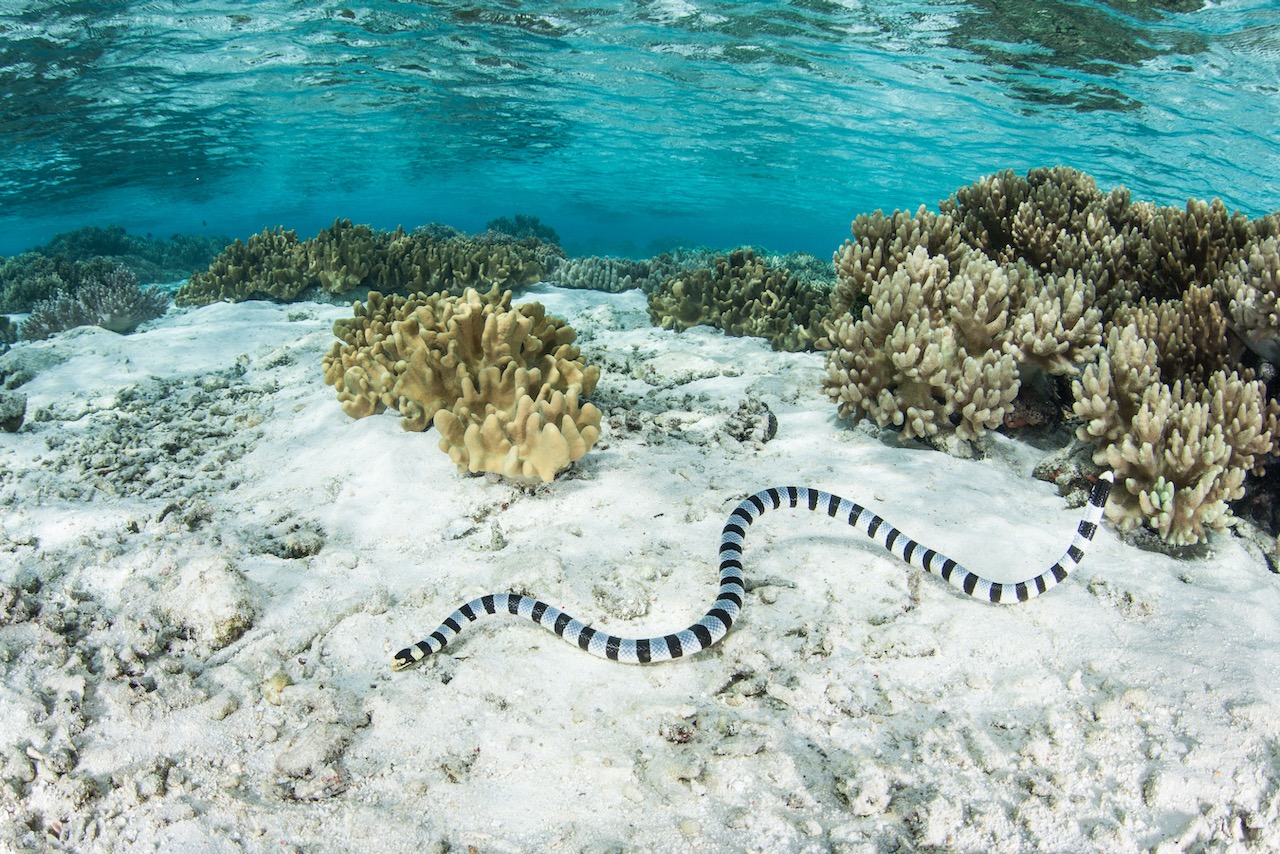
13. A sea snake can be longer than you are tall.
While most sea snakes only grow to be 3 to 5 feet (1 to 1.5m) long, some species can stretch out longer than the average human is tall. In particular, the yellow sea snake (Hydrophis spiralis), which is found in the Persian Gulf off the coast of Oman, the United Arab Emirates and other nearby countries, can grow up to 9 feet (2.75m) long.
14. Some sea snakes are nocturnal.
Sea kraits and a few other species of sea snakes are nocturnal, meaning they prefer to hunt at night. So, if you want to see their most interesting behaviors, consider becoming a PADI Night Diver.

15. Sea snakes are highly venomous.
You may be wondering, “Are sea snakes venomous?” The answer is, yes, sea snakes are highly venomous. In fact, many sea snake species have more venom than the average cobra or rattlesnake.
However, bites are extremely rare. Sea snakes are surprisingly docile and usually only bite when threatened or compromised. Fishermen sustain most of the world’s recorded sea snake bites. These mostly occur when they need to remove sea snakes from their nets or accidentally step on them in the water.
16. Some sea snakes are close to extinction.
While most sea snakes are not endangered, some species are present on the IUCN Red List. Laticauda crockeri (Crocker’s sea snake) is listed as vulnerable, and Aipysurus fuscus (Dusky sea snake) is endangered. Of most concern, however, are Aipysurus foliosquama (Leaf-scaled sea snake) and Aipysurus apraefrontalis (Short-nosed sea snake), both of which are critically endangered.
Climate change, bycatch and low reproductive rates are the main causes of sea snake population decline. You can help by getting involved with awareness and fundraising campaigns that support global change. Consider signing up to become a PADI Torchbearer and join our movement of ocean lovers making a difference to marine life and marine environments worldwide.
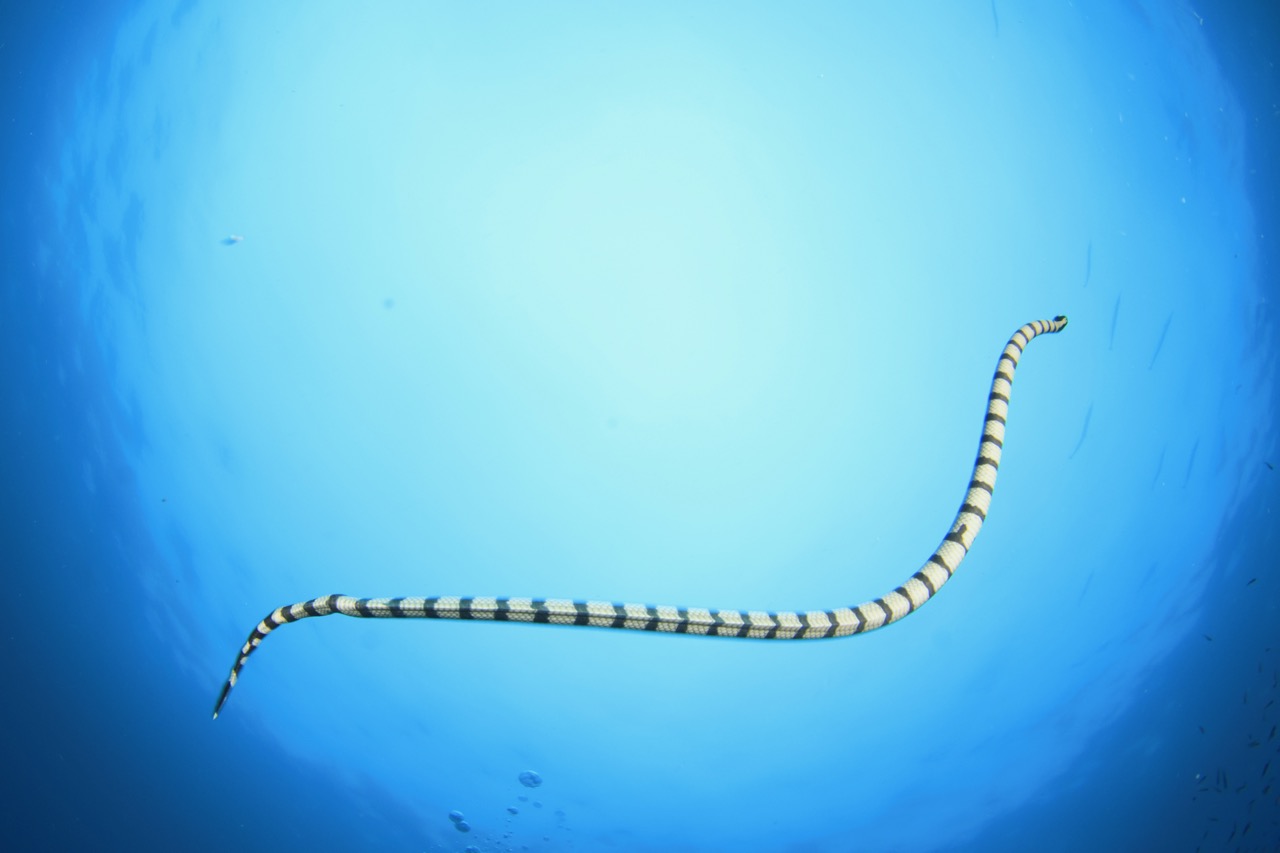
Aren’t sea snakes fascinating? If you’re interested in observing sea snakes during a scuba diving trip, you’ll need to travel to the Indian or Pacific Oceans. The Philippines, Indonesia and Australia are great destinations for diving with sea snakes. Just remember to treat these venomous animals with respect. As with all marine life, keep your hands off, don’t touch and maintain good buoyancy.
If you are not yet a PADI Diver, learn about getting scuba certified, or book your next vacation with PADI Travel to dive with sea snakes.
